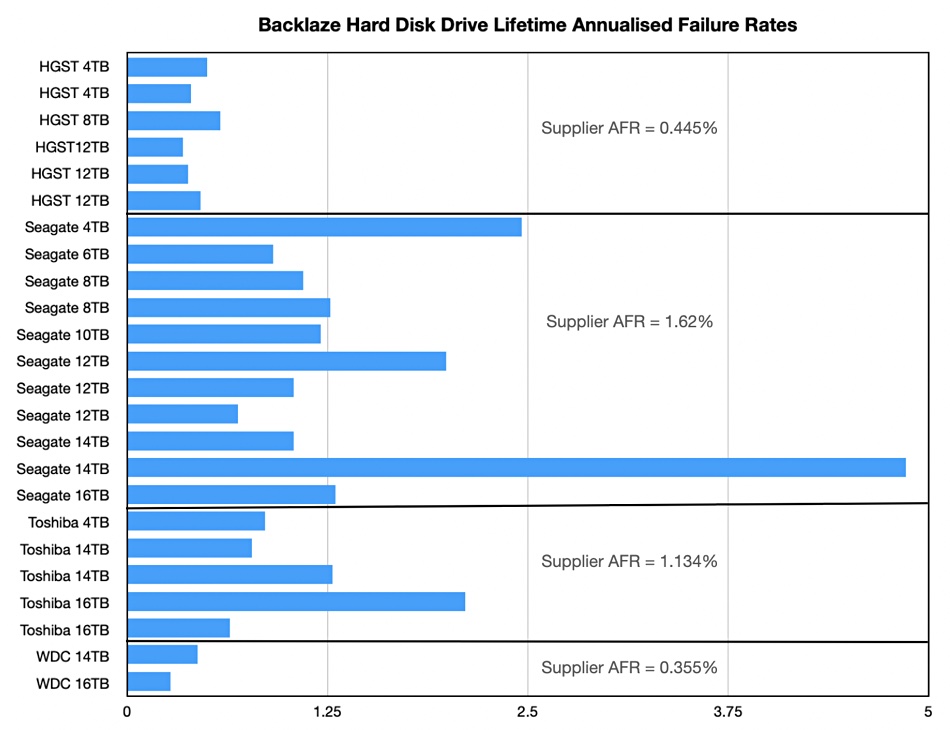Seagate's new Mach.2 dual-actuator hard drives gain capacity and performance.
Seagate Launches 2nd Gen Dual-Actuator HDDs: 18TB at 554 MBps : Read more
Seagate Launches 2nd Gen Dual-Actuator HDDs: 18TB at 554 MBps : Read more
How's Seagate's failure rates nowadays? I stopped buying from them entirely years ago, after I noticed that something like 80% of all my failed drives were by Seagate.

Still frequent I'm afraid..

Backblaze finds Seagate disk drives fail most often – Blocks and Files
Cloud storage provider Backblaze has found that Seagate disk drives failed more often in the last quarter than those from other suppliers. It accumulates failure statistics every quarter for its tens of thousands of disk drives and uses these to calculate life time annualised failure rate (AFR)...blocksandfiles.com
Don't know about this year though.
Just imagine if they tried selling this but as firecuda/barracuda. Could give less reasons to go for sata SSDs of 2 or 4 tb..
WD made the smart move of buying HGST. It took a really long time to get them merged, but I think all of their HDDs are now HGST-designed.WD went though a similar quality phase, but not nearly as bad imo.
More than that, I expect.Why! it doubles the chance of failure.
That doesn't sound like what the article is saying.The dual actuator just means that you have a central Disk with 2 reading arms either side of it.
The article claims there are indeed performance benefits. Otherwise, what's the point?It certainly won't double reading time
Actually, no. There is a single spindle but the actuators are located on top of each other. The advantage is that they can operate independent of each other, each on half of the platters. It's more like having 2 HDD inside one package or Raid-0 like.Why! it doubles the chance of failure. The dual actuator just means that you have a central Disk with 2 reading arms either side of it. It certainly won't double reading time, it adds complexity to the controller circuit, needs more Cache and has double the chance of failing due to power loss when the drive is reading or writing, or when the case receives shock whist in use.
Otherwise it is a decent Idea, like a multicore CPU.
The whole point is Seagate needs to build in a internal RAID 0 to improve performance without me having to do anything.Why! it doubles the chance of failure. The dual actuator just means that you have a central Disk with 2 reading arms either side of it. It certainly won't double reading time, it adds complexity to the controller circuit, needs more Cache and has double the chance of failing due to power loss when the drive is reading or writing, or when the case receives shock whist in use.
Otherwise it is a decent Idea, like a multicore CPU.
Yes, they need to find a way to improve HDD throughput within the confines of a standard 3.5" enclosure. The right way to think about this is improving HDD performance density.The whole point is Seagate needs to build in a internal RAID 0 to improve performance without me having to do anything.
That's the whole point of Multi-Actuator
That happens naturally anyways, the biggest improvement in HDD is "Multi-Actuator".Yes, they need to find a way to improve HDD throughput within the confines of a standard 3.5" enclosure. The right way to think about this is improving HDD performance density.
Not fast enough. Increasing areal density tends to give you a natural increase at the square root of the platter capacity, which eventually becomes a problem for backup times & RAID rebuild times.That happens naturally anyways,
I concur, that's why I'm WAY more excited over "Multi-Actuator" tech, that can help grow linear/sustained transfer throughput at a greater rate.Not fast enough. Increasing areal density tends to give you a natural increase at the square root of the platter capacity, which eventually becomes a problem for backup times & RAID rebuild times.
The article said that part is under control of the host software. My guess is that the sectors are evenly divided between the two sets of platters.And it brings with it all the problems associated with raid 0 , and how when the drive starts filling up, the drive indexing also takes a shot at the efficiency, as too does the complexity of the controller.
This is for enterprise and datacenter customers. If they're ever marketed to consumers, it would be as NAS drives.It will at best speed up loading times, but it won't match SSD levels, and largely you'llnot see any FPS improvement.
Heh, not necessarily. The rest of the drive could potentially remain readable.And one arm fails, the whole thing is useless
I'd guess they're provided only to large customers. According to the article, software changes are needed to properly utilize them, which means they're unlikely to reach consumers unless/until Windows gets patched with support for them.So where the heck are they?


